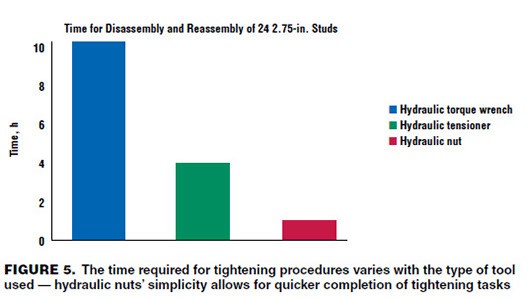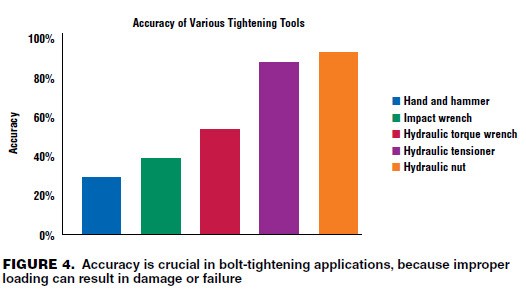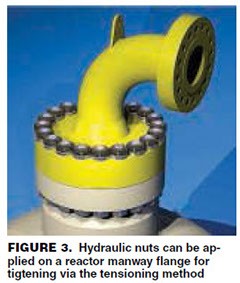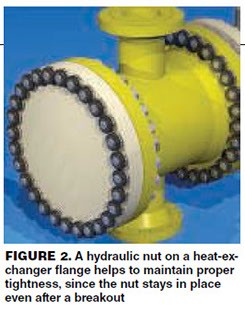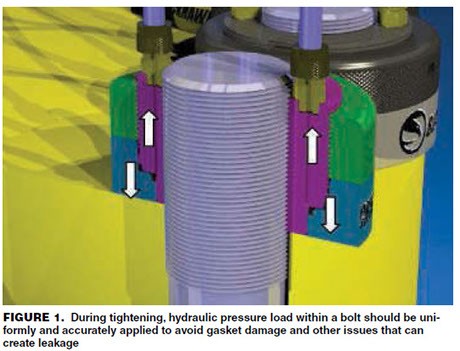Critical Connections Demand Certainty
Understanding bolts’ behavior during routine tightening procedures helps to ensure leak-free, reliable operations
Common knowledge dictates that planning ahead ensures effective results, regardless of the task at hand. Controlling the process is essential to controlling the outcome. Operations in the chemical process industries (CPI) require accuracy and attention to detail, right down to some of the smallest elements — bolts. Delays, defects and accidents in the CPI can be avoided by improving the effectiveness and reliability of bolted joints. Many questions arise when considering bolt performance and maintenance. For instance, how often does one pay attention to the behavior of a stud bolt when tightening? How often should routine tightening checks be completed, and how does one know which tightening method is best for a specific application? Some of these issues can be addressed with an understanding of bolts’ behavior under various tightening methods.
Bolted flanges are certainly not designed to leak, and simple procedures and maintenance routines exist to help prevent prolonged shutdowns, save on costs and improve overall safety. With proper planning, downtime due to leaks and related issues can be minimized, thus increasing revenue and reducing project creep. Most importantly, safety remains the number one focus of the job for the personnel performing the work. It seems all too common that planning for a failure is built into a project’s schedule. In reality, planning for zero leaks at startup is a reasonable and completely obtainable goal. This article provides insights regarding tightening methods — specifically torqueing and tensioning — for bolted connections, and their importance in preventing leaks and maintaining normal operations.
Connection fundamentals
Before going into detail about tightening options for bolted connections, it is important to understand the preliminary work that is crucial to a truly successful connection. Flange alignment, both before and during tightening, is essential to the flange’s integrity. Particular care is required during the assembly of the flange to avoid misalignment or pipeline tension, both of which can reduce the effectiveness of the bolt load and create circumstances that promote undesirable leakage. Misalignment not only detrimentally affects the bolt load, but may also damage the gasket, bend the bolts or unset the nuts, all of which will adversely affect the joint’s integrity.
Gasket seating requires the correct amount of gasket compression. This compression must be uniform around the entire gasket surface. Correct gasket compression is achieved by precise and uniform bolt loading. Distortion of gasketed joints usually causes a non-uniform pressure distribution over the gasket. Joint distortion exists when the flange faces are not parallel or the bolts or studs experience deformation outside of that caused by normal tightening activities. There should be an equal space between the faces at the top and bottom and on each side of the flange.
Flanges become distorted when flexing occurs at the flange, usually due to uncontrolled bolt loads, which leads to leakage at points where compression is too low for sealing. A flange can be checked for distortion by taking a face run-out reading of the flange as it is rotated slowly on a portable lathe. Lasers can also be used for more exact readings. Furthermore, by employing a non-drying blue pigment and an accurate straightedge, the amount of warpage or waviness in the flange face can be detected by observing the contact points. Machining of the faces may be required to restore the flange face to the required flatness and desired sealing surface. Even with relatively rigid flanges, bolt loads can cause a certain amount of bending in the flange between bolt centers.
Internal pressure also adds to the loading on flanges, gaskets and bolts. Internal pressure can cause bolt elongation, add to flange bowing and cause gasket blowouts. The internal pressure creates forces that act to separate the flanges. The bolt cross-section in Figure 1 shows the directional path of applied internal hydraulic pressure through the element. The bolt loads must be uniform and accurately applied to keep the stress in the gasket, resisting gasket blowout. Needless to say, given the variety and intricate details that go into the makeup of a bolted connection — namely, gasket type, sealing-face finish and the flatness and stiffness of the flange — simply adding more bolt load to a leaking joint may not always be the most suitable solution. It is important to investigate the situation and confirm that additional tightening is the best path moving forward. Other options may include flange machining or upgrading the bolts and gaskets themselves.
Bolt behavior
Any tightening method applied will result in stretching of the bolt. The bolt behaves like a spring, in that it has a certain elastic limit that it can reach and still return to its original shape and size when the force is removed without incurring any distortion. If a bolt is in tension, the stress it experiences is a tensile stress, representing the amount of force applied. Tensile strength is the maximum tension applied stress a fastener can support before it fractures. The amount of distortion occurring in a part, as long as it is kept within the material’s elastic limits, will be directly proportional to the applied force. If the force exceeds these limits, the result is permanent set. Permanent set of a bolt refers to the elongation that remains in a fastener after it is unloaded, and is also commonly known as necking or yielding.
Simply put, necking occurs when a bolt is stretched past the spring-like state and the bolt becomes longer than it originally was. In this situation, the bolt is overstretched and the material to create this length has been displaced from other areas of the bolt. Typically, bolt material is transferred from the diameter when this elongation occurs. It is not visibly apparent when the stud bolt is engaged, but this material migration can cause major problems if ignored or unnoticed. Necking decreases a part’s strength, which therefore reduces the integrity of the bolted joint as a whole. When the bolt needs to be tightened again, there will be a new stress-strain curve and the thread pitch (how closely the threads in a screw or bolt are spaced) will change, even on the threads that were not engaged during tightening. Hence, when comparing a new or properly used bolt to a bolt of the same makeup that has previously exceeded its capacity, the threads will not match.
Yield strength is another important parameter in bolt tensioning. It is defined as the tension-applied stress at which the fastener experiences a specified amount of permanent deformation. When tightening a bolt, it is crucial to remain below the yield strength up to the proof load. The proof load is typically defined as the tension applied load that the fastener must support without evidence of any deformation.
Unfortunately, it is a common misconception that simply tightening a joint is something of a cure-all for leaking connections. Of course, there is the possibility that tightening the joint will correct the issue. However, the likelihood also exists that the joint was previously overtightened and therefore has compounded problem areas, including necking issues or distorted flange faces. This brings up a key point that illustrates how essential it is to maintain accurate records of the work performed on each application. Detailed documentation saves time and resources regarding the continued maintenance and performance of any asset.
Bolt-tightening methods
Several methods of bolt tightening are in practice currently. Bolting practices and technologies have evolved in many ways over the years. In the past, the tightness of a bolted joint relied almost entirely on the physical strength of the individual operating the manual torque wrench. As technological efforts progressed, the pneumatic impact wrench was introduced to simplify control and provide improved accuracy. Hydraulic torqueing followed, further allowing individuals to rely more heavily on the tool itself rather than personal strength. Yet another method, hydraulic tensioning, is a more recent development that can drastically reduce inaccuracies and elevate the level of safety in tightening applications.
Hydraulic nuts are a very versatile type of tool used in tensioning procedures. Installation applications for hydraulic nuts include heat exchangers (Figure 2) and reactor manway flanges (Figure 3), among others. The primary distinguishing feature of hydraulic nuts compared to other tightening tools is that the hydraulic nut remains on the application flange until the next breakout, essentially replacing the nut itself.
The possibility of damaging a bolt during the tightening procedure should be taken into account, regardless of the method selected to perform the job. However, the accuracy in properly distributing the desired load varies when comparing bolt-tightening methods. For example, tools used for tensioning are designed to not cause yielding in the stud. As long as the correct calculations are taken into account and tools are used properly, it is physically impossible for stud yield to occur with tensioning. Tensioning also eliminates the risk of galling (wear due to adhesion between surfaces) during breakouts.
Each application is different, and there are various factors to consider when determining the best tightening method for individual cases. In some cases, tensioning can be the safest and most accurate method available, but there are specific requirements for its application, including stud spacing and the number of exposed threads on the length of the bolt. Stud spacing is a limiting factor for the application of tensioning because there must be enough room between studs on the flange for the tools to maneuver. Also, there must be an adequate length of exposed thread (typically 1.5 times the diameter of the thread) for the tool to adhere to, unless customizations have been applied to the tools.
When compared to other bolt tightening methods, tensioning has many advantages. Bolt tensioning uses a hydraulic jack to apply force directly to the end of the bolt. The stud bolt is “stretched” to a pre-defined limit or proof load, and the operator is then able to tighten the nuts to the flange face. Also, unlike other methods, friction is not an issue with tensioning. The hydraulic load is transferred from the tensioner to the nut by a simple turn of the nut by hand. After this maneuver, the stud bolt remains tensioned.
Despite these advantages, tensioning is not the most common method of bolt tightening applied in industry. Currently, the most common bolt-tightening method is torque tightening, or torqueing. Torqueing uses the thread helix of the turning nut to elongate the bolt. Obtaining uniform bolt loading to seal the gasket with torqueing is challenging, due to difficulties related to controlling friction. Crosstalk (elastic interactions between grouped bolts) in the flange also hinders bolt-loading uniformity when torqueing is applied.
Another advantage is that the process of tensioning is not dependent on the type of lubricant used. Torqueing is greatly affected by friction, and proper lubrication is crucial. Friction is found both under the bolt head and in the threads of the stud during tightening. Friction is the biggest issue that must be considered when calculating the appropriate yield for each application. About 50% of the input torque goes directly toward mitigating the friction found under the bolt head. Another 40% of the input torque is lost in the thread frictions, leaving the remaining 10% of input torque to stretch the bolt. The application of lubricants helps to reduce friction in these situations. A well lubricated bolt will stretch more and exert a higher clamping force than a dry bolt. The bolt force applied must be great enough to create a “flow” phenomenon at the surface of the gasket material and cause it to yield and seat effectively. The bolt force must always exceed the force due to internal pressure to ensure the contents passing through the connection points remain contained.
When torqueing a bolt set, immediately after the fasteners are tightened, the assembled joint will relax with an accompanying loss of 2–11% of initial bolt preload — the tension caused by the tightening action itself is diminished. Several events may happen in the joint, including: rough spots on contacting surfaces may flatten; mating threads may accommodate to each other; the bolt head and nut may embed into the jointed material; and fasteners may adjust to non-parallel bearing surfaces. These reactions cause relaxation. Relaxation of the load at bearing surfaces, along with friction and cross-talk, reduce the accuracy of torqueing methods. Figure 4 shows a comparison of the accuracy of various bolting tools. Torque methods often only have a bolt-load accuracy of 50%. With critical connections demanding precise control over bolt load and uniform gasket stress, torqueing can fall short in these areas. Conversely, hydraulic tensioners and nuts provide increased bolt-load accuracy. The tensioning method eliminates the effect of friction under the nut and between threads by applying force directly to stretch the bolt. By taking friction and cross-talk out of the equation, more accurate bolt loads are obtained. To ensure leak-free startups, bolt loads applied by hydraulic nuts are approximately 90% more accurate than torqueing.
Employees’ time is another resource that must be considered when examining bolt tightening and maintenance. With tensioning, every alternate bolt or every individual bolt may be tensioned simultaneously to pull down the flange evenly. Multi-stud tensioning eliminates bolt load cross-talk. Bolt tensioning can simultaneously achieve accurate and predetermined bolt loading in a single operation, providing the uniform gasket compression that is essential for the integrity of critical bolted connections. Particularly on larger flanges, bolt tensioning can also be significantly quicker than torque tightening. Since torqueing tightens each bolt in succession in a star-like pattern across the flange face, a multi-pass approach is required. Some of the already tightened bolts may need to be re-tightened throughout the entire procedure, thus requiring significantly more time. Figure 5 illustrates that torqueing operations require considerably more time than hydraulic tensioning methods. Tensioning can potentially reduce the time required to remove and replace large, high-pressure flanges by up to 80%. Furthermore, when compared to other methods, less manpower will be required to accomplish the same tasks when tensioning is applied.
Because tensioning facilitates simultaneous tightening, any number of tensioning tools can be connected together. This sort of configuration can simultaneously tension either 50 or 100% of the bolts on a given flange, producing uniform gasket compression and eliminating the damage incurred by bowing or overloading the flange. Underwater tensioning is usually 100% simultaneous to simplify the work of the diver. Topside applications generally tension alternate bolts in two passes from the same side of the flange. Stud bolts are set with an additional one diameter of length protruding on the same side. Hydraulic bolt tensioners are fitted to every other bolt for the first pass before being moved to the remaining bolts for the second pass. Where access is restricted, some bolts can be tensioned from the other side of the flange. Subsea applications are set with the additional length protruding on alternate sides of the flange. Hydraulic bolt tensioners are attached to every bolt on alternate sides of the flange in order to obtain 100% simultaneous tensioning. Tensioning’s simultaneous tightening capabilities across a flange face greatly decrease the amount of time spent on each face. Since the nuts remain on the face, tensioning also eliminates the threat of inherent pinch points while tightening stud bolts. Pinch points are areas where a technician’s skin or extremities can get pinched by tools, causing potentially catastrophic injuries. Along with creating a safer work environment for personnel, this type of procedure results in a more effective and faster turnaround, greatly reducing costs.
CPI operations demand a certainty of outcome to deliver reliable, leak-free connections with zero delays and zero accidents. New bolt tightening technologies, such as multi-stud tensioners and hydraulic nuts, should certainly be considered to help deliver the high level of reliability that critical bolted connections in the CPI demand.
Written by:
P. Gordon Britton, P. Eng.
President and CEO
INTEGRA Technologies
This article appeared in the November 2014 edition of Chemical Engineering Magazine and was edited by Mary Page Bailey in that magazine.
(C) INTEGRA Technologies Limited and INTEGRA Services Technologies, Inc. 2016. All Rights Reserved.
Critical Connections Demand Certainty Gallery
Get A Quote Today
One of our experts will be in touch within 24 hours to provide a free quote and advice.

